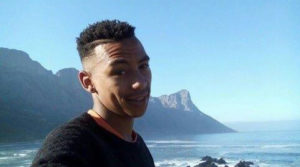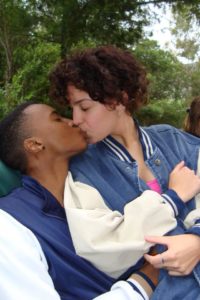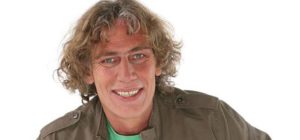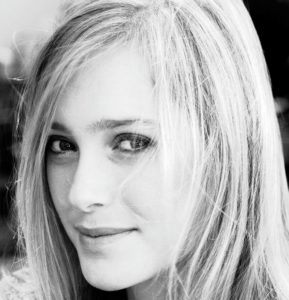Dan Roodt, American Renaissance, June 10, 2017
I grieve for one of my tribe.

Hannah Cornelius
Hannah Cornelius died on Saturday morning, May 27th. The 21-year old student was abducted in her own car by a Coloured (mixed-race) gang in the university town of Stellenbosch, near Cape Town. They drove her away, gang raped her, and then strangled and stabbed her. Her body was found at two o’clock that afternoon. Horrors like this hardly reach the front page anymore, so inured have we become to liberal, multicultural South Africa.
When people are killed here, they become hashtags. So it was with #HannahCornelius. After the initial flurry of tweets, the news died down. A friend once compared our reactions to murder to that of a herd of gazelles grazing on the savannah. Now and again a predator catches one; the herd shudders, but life goes on. An hour or two later the herd is at ease again, nibbling juicy leaves of grass.
Hannah Cornelius was strikingly beautiful, kind, full of laughter, and a straight-A student at Stellenbosch University. She spoke Afrikaans, English, and French—a foreign language she studied at school. The mainstream media carefully omitted the race of Hannah’s killers; they were simply “men.” White feminists let loose a barrage of their favorite hashtags, such as #menaretrash, with the implication that white men, too, were collectively responsible for Hannah’s death. Another favorite leftist cliché was quickly applied: “gender-based violence.”

Four Coloured men have been arrested for the crime. This is, in itself, a miracle, since most homicides in South Africa are never solved. Only 8 percent of murderers are convicted, so they have a 92 percent chance of, literally, getting away with murder. Affirmative action has taken its toll on the police, especially in the more technical departments such as forensics. However, CCTV footage of Hannah’s hijacked little blue Volkswagen Golf—a gift from her 91-year old grandmother—helped police find the killers. All four have all been charged in the Stellenbosch Magistrate’s Court with murder, rape, car theft, robbery, and abduction. They will again appear on 28 July 2017 when more details of the crime should emerge.
Newspapers have focused on Cheslin Marsh, a male Stellenbosch student who was with Hannah when she was hijacked in the early hours of Saturday morning. The attackers drove him around in the trunk of the car and later pelted him with bricks. Mr. Marsh ended up in the hospital with a broken arm, and will probably be a key witness at trial.
Cheslin Marsh’s picture was published in the press; he is Coloured. What was Hannah doing at four in the morning alone in a car “having a conversation,” as it was reported, with a man of the same race and culture as her attackers?

Cheslin Marsh
I have been haunted by the murder of this beautiful young Afrikaner, and I tried to find out more by speaking to another Stellenbosch student. I learned that Bird Street, where Hannah was carjacked, is notoriously dangerous, since it is fewer than 2 kilometers from the black township in Stellenbosch known as Kayamandi. Someone else familiar with the university told me that “all the Stellenbosch girls are very scared of the Coloured gangs, and being attacked by them.” So why was Hannah not afraid, and why was she parked in a dangerous street in the early hours of Saturday morning when criminals might be on the prowl?
There are clues. She had a former boyfriend named Fanelo Arens—also Coloured. They met when they were students at a liberal, private, English-language high school called Reddam House. This says a lot about the environment in which she grew up.
Afrikaans-language government schools may be the last bastion of white racial consciousness in South Africa. That is why our government is waging a kind of war against them, as well as against white home schoolers. I had a conversation with some girls at an Afrikaans school here in Johannesburg and they all said that they were revolted by interracial dating. As one told me, “The idea of being kissed by a black or Coloured boy makes me sick.”
I suspect Hannah would have retained some element of race realism if she had been educated in a normal Afrikaans school of which there are still many available at a high academic level. Somehow, her lawyer parents decided to uproot her from their own traditions and push her along the internationalist, globalist, multicultural route. In a sense, that was Hannah’s first death, or the first crack in the armor that every white girl needs in ANC-run South Africa.
And so it was that in her first year at Reddam House—she must have been no more than 13 or 14 years old—she was spotted in the library by Fenelo Arens, three years her senior. He started courting her and eventually became her boyfriend. On Fenelo Arens’s Facebook there are photographs of him holding or kissing white girls.

Fenelo Arens
In just a few decades, South Africa has gone from being probably the most anti-race-mixing country in the world to one in which it has become almost de rigueur—with all the tragic consequences.
Hannah was therefore being broken down long before the fateful Saturday morning when she met her grisly end. As my student source at Stellenbosch University explains: “Liberalism is like a brain tumor; it grows and grows and eventually affects your judgment. Hannah’s judgment must have been impaired to be sitting in that road at that hour.”
Hannah Cornelius was an Afrikaner—a member of my own tribe. Sometimes when I meet a pretty young girl who speaks English with a strong South African accent I ask if she is not Afrikaans-speaking, with English as a second language. Sometimes such a girl replies: “No, I am English. But people often tell me I look like an Afrikaans girl.”
There is a certain look, a certain style that constitutes the “Afrikaans girl.” It is exemplified by the (horribly liberal, alas) Hollywood actress Charlize Theron, and by the many models from South Africa who have become internationally famous for their beauty.
 

Charlize Theron (Credit Image: Wikimedia)
We are a distinct people, descended from 40,000 Dutch, French, and German immigrants who lived in the Cape in the 18th century. We are bound by language, culture, and genes. Our quirky Dutch, German, and French-Huguenot surnames follow us, even when we emigrate to Australia or Canada.
In a sense, Hannah Cornelius—my kinswoman—never had a chance. Even with her beauty, intelligence, excellent grades, mastery of French, and so on, she was never allowed to develop into a normal, care-free, protected Afrikaans girl, moving mostly in a white environment, meeting white boys her age at teenage parties or braais (our word for barbecues). Instead, she was flung into the liberal melting-pot, her identity confused, her corpse finally collected by the South African Police Service from a dirt road on the outskirts of Stellenbosch.
There are similarities between her death and that of the American Fulbright scholar Amy Biehl, who also came from a liberal home and supported the radical black movement in South Africa. As we know, she was stabbed and stoned to death by a black mob on August 25, 1993 after giving a lift to a black student to Gugulethu, the black township outside Cape Town.
Amy Biehl’s liberal parents, Peter and Linda, set up a foundation in her name to help other young blacks from the very area where she was killed—in a sense rewarding them for murdering her daughter. Willem and Anna Cornelius have also spoken of starting a charitable foundation in memory of their slain daughter. It sounds ominously familiar.
In novels and in real life, we interpret the story of someone’s life differently when we arrive at the end. Only then do we recognize some of the clues strewn on the way that help explain what may be a shocking conclusion.
That is why I say Hannah died three times: Once when she was uprooted from her family and her national tradition, once when she consorted with someone not of her own race, and once when the Coloured gang mauled her to death.
In other countries, people may be free to experiment and take social risks. In South Africa, such risks may be fatal. Where you live, where you go to school, whom you associate with, where you shop, where you park your car—all determine your chances of survival.
Even before I finished writing about Hannah Cornelius, news broke of another blond-haired Afrikaner turned into a hashtag: #JohannBotha. He was a TV and radio presenter who also happened to be an opera aficionado. Once more, the mainstream media are presenting his death as a kind of incomprehensible accident, something incongruous beyond our understanding. Johann Botha was shot in a bar by four black robbers in downtown Johannesburg, along with the bar owner.

Johann Botha
I met Johann a few times, among the media fraternity here in Johannesburg. For years he was the host of a successful TV program about South African wildlife and conservation. His views tended towards the liberal. Like Hannah, he was a gentle, caring soul.
In exasperation I tweeted:
If you have blonde hair and speak Afrikaans, you’re gonna get murdered in South Africa… #HannaCornelius #JohannBotha
— Dan Roodt (@danroodt) June 8, 2017
Of course, English-speaking whites also fall prey to our roving murderers, but two of our own had become hashtags in just one week. Immediately, a horde of blacks and liberals attacked my tweet, calling it “racist,” threatening me with complaints to the South African Human Rights Commission, for which “human rights” means “hunting down white racists.”
Members of my own tribe are being mercilessly hunted down, but because we are white we must not be angry. Because we are white we deserve no sympathy.


Students at the University of Stellenbosch are filled with fear after the hijacking and murder of student Hannah Cornelius. Picture: Facebook
Hannah Cornelius

